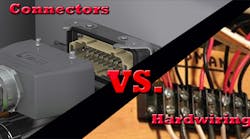Your industrial machines’ motion control components aren’t moving anywhere or anything without the cables that send the power, signal, and data. When deciding how exactly to connect these cables, you have two options: hardwiring the system or using connectors for plug-and-play capabilities.
Raj Desai, product manager at cable manufacturer Lapp USA, says in most situations, choosing modular connectors is the way to go, even though hardwired systems cost less upfront.
“There are hidden costs that are associated with hard wiring,” Desai says. “You have to look at total system costs versus what the upfront costs would be from buying connectors versus hardwiring.”
This is detailed in the company’s declarative white paper “Connectors Lower Wiring Costs,” and we caught up with Desai to break down exactly how and why this is the case.
1. Installation Time:
When shipping hardwired components, they have to be dissembled prior to sending to the customer, and then reassembled when received.
“For the reassembly, the customer tend to hire electricians or contractors who don’t know the equipment as well as the original manufacturer,” Desai says. “Wiring issues can come up.”
Those issues will lead to failed tests, and then a lengthy evaluation process to determine what went wrong, Desai says.
Connectorizing takes all the guesswork out, especially when there are multiple connectors are mounted side-by-side. Male and female receptacles can be keyed so they only mate with their appropriate counterpart.
“Connectors are designed to prevent any miswiring, Desai says. “With keyed pins, you can’t plug a connector in wrong, and you can’t make those mistakes you could possibly make with hard wiring.”
2. Labor Costs:
The graph below demonstrates how much more hardwired machines can cost once the customer receives it.
Graph: Lapp USA
This is because of all that reassembly, testing, and retesting. Those electricians and contractors aren’t working pro bono, so it’s going to cost you.
You can avoid this by sending out a technician who knows the machine better and will be more likely to assemble the equipment faster and without errors, but again, you have to pay for labor and travel costs.
3. Free Up Your Maintenance Crew
Imagine you have a motor using connectors and the component goes down.
“It’s simply a matter of disconnecting the connectors and putting the replacement on,” Desai says. “The maintenance engineers could do it right on the line.”
What’s it like with hardwired assembly line?
"Many assembly lines require the flexibility to build various products on a single line," Desai says. "This requires a change in personal, components, and equipment in short time. This obviously would be very difficult with hardwired equipment and thus the need for connectorized equipment. In addition, when appropriate, the change can be performed by the very personnel at the assembly line. It does not require calling on busy maintenance personnel to make the change. Maintenance, on the other hand, can be quickly changing out connecterized equipment that is of need of repair and replacing with back up equipment to keep the line going."
4. Production Time
Desai says overall, connectors provide 60 to 70% in savings in labor and production time. If a robot breaks down on an automobile assembly line and work stops, it could be even more.
“When production is down you could lose hundreds of thousands of dollars,” he says.
Because disassembling hard wired machines takes more time, a company could hemorrhage money every extra minute it takes to replace the part.
With plug-and-play connectors, that downtime is reduced, therefore reducing production downtime. Refer to the chart above to see just how big a difference this makes.
5. Design and Lead Time
Modular connectors can combine power, control and data into one, and are available in high voltage, high current, thermocouple, Profibus or Ethernet versions. This provides obvious flexibility and saves space on equipment, making it much easier for engineers to design whatever machine they need.
Lapp says the lead time for their connectors are comparable to off-the-shelf products, allowing manufacturers to get the connectors they need quickly and deliver the product on time.
Summary:
Desai says despite all the reasons to the contrary, the split between hard wiring and connectors is still “50/50.”
Why does he think that is?
There’s a disconnect between management and the people on floor,” he concludes. “Management looks at upfront cost, while factory floor sees the overall benefits.
He says the white paper has helped turn the tide.
“Once management sees benefits from assembly point of view, and realize the increased cycle time and quality, it’s a win-win from that point.”












